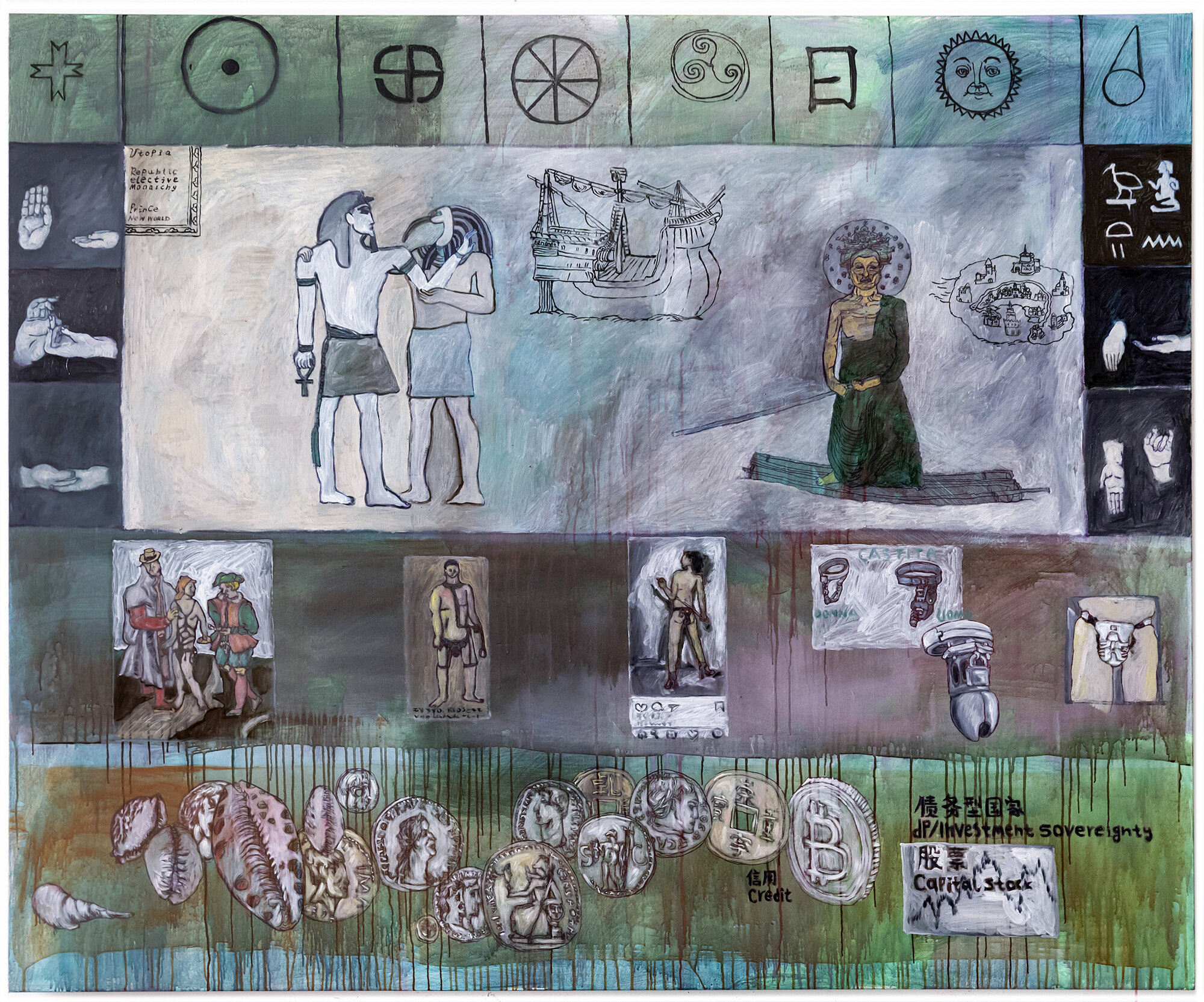Sun Wang
Sun Wang was born on July 19, 1994. He received his B.F.A degree from the Maryland Institute College of Art in 2016 and an M.F.A degree from Cranbrook Academy of Art in 2019. Currently, Sun lives and works in Pontiac, Michigan.
Inspired by comic books and religious altar paintings, Sun makes narratives in non sequential storyboards on canvas, creating an interactive visual experience for the viewers where the narrative happens in between the frames. The storyboard illustrates the interwoven relationship between parts and the whole and the coexistence of randomness and system in aestheticism, tracing human conflicts' roots and understanding how we failed to achieve social justice and pacify ideological and social-economic struggles.
Q&A between Gabriella Grill and Sun Wang
Change and Truth; Oil and acrylic on canvas; 60X72 in.; 2019
Light of Hope; Oil on canvas; 60X72 in.; 2019
GG: Your style of painting makes me think about collage, comics, rugs, tapestries, and manuscript painting. Can you describe the influences to the format of your work?
SW: Pictorial reading is my primary goal when creating my compositions. My most significant influences are comic books and renaissance altar paintings and murals. Also, Chinese scroll paintings and stone engravings attached to ancient Chinese architectures impacted my painting's format. I am interested in giving a minimal amount of information, highlighting the most essential details of a mythological tale or a historical event, and leaving the viewers' room for imagination and interpretation.
Voynich Manuscript; Oil on canvas; 60X72 in.; 2019
GG: Many of your paintings depict deities and religious symbols. What is your relationship to religion within your work?
SW: I am interested in religious metaphors and how they play a role in describing human behaviors and historical events concisely and poetically. Studying the relationship between cultural symbols and how different societies adapted these symbols, whether politically or aesthetically, creates a cohesive way for me to tie seemingly unrelated events and stories together.
Flowing Time; Oil and acrylic on canvas; 60X72 in.; 2019
GG: Your paintings draw attention to facets of civilization throughout history, including financial capital, textiles, technological advancement, class, religion and mythology, colonialism, sovereignty…the list goes on. Can you expand on the connections made between the different elements within any one painting?
SW: In the 'Realm of Cards,' I was initially trying to make a painting after discovering how all the cards that had a face referred to one or more famous royal people in European history. All the historical figures referenced in the poker cards were from around the feudalist period of European history and about the age of discovery, and around when the Black Death pandemic happened. I was trying to convey that human history consisted of competitions and partnerships, and it's very much like a card game where the enemy of my enemy is my friend. However, I thought that nature is really the bookmaker in any given time of human history, so I made the frame of that painting depicting the pandemic.
Realm of Cards; Oil on canvas; 60X72 in.; 2019
Intersecting Spacetime; Oil on canvas; 40X60 in.; 2019
Underworld Within the Heart; Acrylic and pastel on canvas; 60X72 in.; 2019
GG: I know that you moved to the USA from China initially to attend the Maryland Institute College of Art for your BFA. Where are you from in China, and how has your sense of home influenced your work?
SW: I am from Chengdu, Sichuan province. The city itself is stereotypically known as the hometown of pandas, hotpot, and people who love playing Majiang. Historically, it was Shu's capital, one of three kingdoms of the three kingdoms period in China. I grew up reading a comic book about the three kingdoms period, so I guess all my current interests come from my childhood.
Lingam; Oil on canvas; 60X72 in.; 2019
Myth; Acrylic on canvas; 60X72 in.; 2019
The Light Tower; Pastel on canvas; 60X72 in.; 2019
GG: You use many symbols throughout your work-an hourglass, a butterfly, the lotus flower, sun symbols, and hieroglyphs. Can you describe your thoughts about language and symbology? Your connection to particular symbols used throughout your work?
SW: The more I learned about Chinese traditional art, the more I understand how language, particularly calligraphy, played a huge role in ancient Chinese painters' artistic practices. The Chinese language came from pictographs, and there is a visual relationship between the Chinese characters and religious symbols because languages were first used by tribes to conduct and document religious ceremonies. I have been trying to develop a way to combine speech with my work directly, maybe performance, I don't know, I still prefer painting as the primary medium.
Follow Sun on instagram @sun_wang3
or find his work online at https://sunwang94.cargo.site










